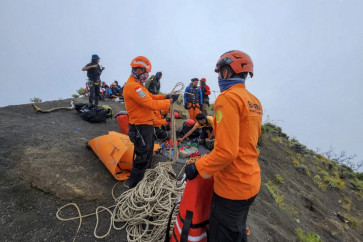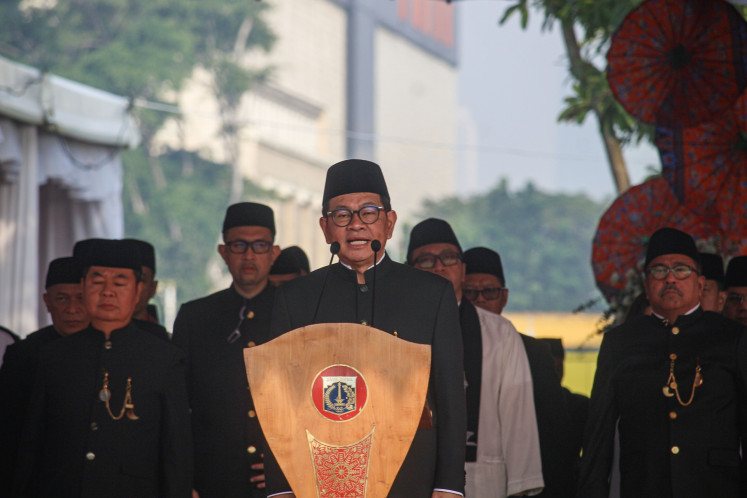Popular Reads
Top Results
Can't find what you're looking for?
View all search resultsPopular Reads
Top Results
Can't find what you're looking for?
View all search resultsKal Muller: Savior of the Kamoro
(Courtesy of Kal Muller)“He is a missionary, who came to our village,” said 33-year-old Herman Kiripi, a wood carver from the Kamoro tribe in Papua, when asked about Kal Muller, the man who has dedicated his years in Indonesia to saving and supporting the tribe’s dying woodcarving tradition
Change text size
Gift Premium Articles
to Anyone

(Courtesy of Kal Muller)“He is a missionary, who came to our village,” said 33-year-old Herman Kiripi, a wood carver from the Kamoro tribe in Papua, when asked about Kal Muller, the man who has dedicated his years in Indonesia to saving and supporting the tribe’s dying woodcarving tradition.
Herman is not 100 percent right. Muller first came to the Kamoro area in central Papua 17 years ago with mining giant Freeport. Instead of dedicating all his time to the company, Muller began to help the local community preserve a tradition that had almost been lost by the people, a choice that has earned him enormous respect among the Kamoro.
“I liked to work with these people and wanted to promote their carving before the skills became extinct. I asked Freeport if it was okay and they said yes,” Muller told The Jakarta Post during preparations for the Kamoro Art Exhibition in Jakarta last week.
Thus began his lifetime of dedication to the Kamoro and after more than 15 years, Hungary-born Kal has not only saved the ancient tradition but also improved the living conditions of the local people beyond recognition. Before the white-haired guy came to the region, the Kamoro’s wood carving was at the brink of extinction. Most people had stopped carving and the young people were not interested in the tradition simply because there was no market for their work. In contrast with their famous neighbors the Asmat, whose crafts had an established global market, there seemed to be no future for Kamoro artwork and the people only carved occasionally, for souvenirs and religious ceremonies.
Until, Muller came to the rescue.
His first involvement in the cultural restoration program occurred when he was asked to manage an auction of the best carvings at the annual Kamoro festival, sponsored by Freeport since 1998. During the event, he managed to sell the carvings for hundreds of dollars with the most expensive going for US$1,200.
Kal then relaunched the program as the Kamoro Arts Exhibition and Sale in 2007 in the hope of wider exposures and a bigger market. Through these exhibitions, Muller has brought the art of the Kamoro to other cities in Indonesia and sold more items. Now 30 exhibitions promoting Kamoro carving later, his wife Jina is assisting him in arranging the latest exhibition in Jakarta.
The couple has helped the Kamoro preserve a tradition that almost died out. Proceeds from the exhibition have become a good incentive for the people to return to carving. The Mullers give the artist a down payment for the work to be displayed in the exhibition and as soon as the pieces are sold, then the rest of the money goes to the carvers.
With this money, not only is Muller helping conserve the culture but improving life of Kamoro. Herman says that many children can go to school because of Kal’s work.
But Muller does not stop with his mission to preserve the local culture. He goes beyond the Kamoro and promotes Papuan culture as a whole.
He has written a number of books about Papua, including school books for local children.
“I am doing it for schools because Papuan themselves don’t know about Papua,” he said of his motivation.
It is amazing to see the spirit of the septuagenarian in promoting the culture that is not his.
Actually, from his looks and gestures, he doesn’t look anything like a 73-year old. He is constantly on the move walking here and there in the exhibition room, checking every detail of the preparations. Such strong stamina, he explains, is a result of regular exercise.
“Where ever I stay, I do push ups, sit ups or stomach exercises, and I try to swim every day, not here in Jakarta but in Timika [Papua], maybe one kilometer a day,” he said.
Muller has also excels in general knowledge. His wife describes him as the man who knows it all, from film, classical music to politics. “He is very intelligent very motivated, he is very driven, he is passionate with what he does, he is interested in the world around him,” said his wife.
When he first approached the Kamoro, according his wife, he did not hesitate to stay overnight at the local people’s houses and eat their food.
Many people consider him an anthropologist, but he is not. Kal holds PhD degree in French literature, and has no educational background in anthropology; he says he only knows the subject through books and a few courses at university.
Before becoming an expert in Papua, Muller had traveled to more than 80 countries and tried different professions from waiter, interpreter, a gym instructor, documentary filmmaker, model, photographer to writer.
His around-the-world journey ended when he visited Indonesia in 1976. After some years, he went to Papua and has since called the land home, dedicating his life to the local people and making their lives better.
Small wonder then, that Herman and all the Kamoro people consider him a messianic figure and a saint to the community.









